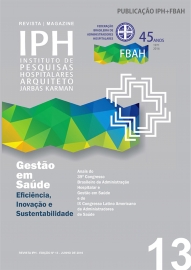Publications IPH Magazine IPH Magazine 13th: Annals Quality and impact of patient safety in the hospital financial result - Santa Casa de Misericordia de Maceió

- Editorial - 13th
- HEALTH MANAGEMENT: Efficiency, Innovation and Sustainability
- Health Management Focused on Efficiency, Innovation and Sustainability!
- CONGRESS FOR COST AND FINANCIAL MANAGEMENT
- Hospitals, networks and sustainability
- Cost Reduction through Process Review
- Integrating Business Management to the Assistance Management
- International experience on the compensation models
- The Future of Hospital System - The Sustainability Challenge of Small Hospitals
- Advances in Patient Safety: Indicators and Impact on Cost Assistance
- Prospects for Public Private Partnerships and the Partnership Arrangements with Health Social - Critical Analysis of the PPP Brazilian Experiences in Health
- ENGINEERING, ARCHITECTURE AND LOGISTICS CONGRESS
- Hospital Logistics: Intelligence at Service for the Health Manager
- PEOPLE MANAGEMENT AND LEADERSHIP CONGRESS
- Illusionist Performance: Transformation and Innovation in Tough Times
- Implementation Careers & Salaries: New Paradigms and Opportunities
- The Art of Leading Generations X, Y and Z - How to retain talent?
- Giving Back Over the Organizational Climate - Talent Retention Strategies
- Creative Practices to Innovate in HR
- HEALTH MANAGMENT CONGRESS
- Efficiency
- Efficiency (2)
- The Process of Change in Bolivia "Hospital Arco Iris" from Solid Hospital to Liquid Hospital
- PATIENT'S QUALITY AND SAFETY CONGRESS
- Impact of External Assessment in Brazil
- Impact of External Assessment in Brazil (2)
- Quality and impact of patient safety in the hospital financial result - Santa Casa de Misericordia de Maceió
- Quality and Safety Integration on Education Process
- Management
- The Apthapi as Innovation Strategy in the Humanization of Healthcare Hospitality
- The experience of the State Hospital Sumaré / Unicamp in management by care
- HOSPITAL HOTEL CONGRESS
- Hospitality in Patient Perspective
- Hospitality at the Service of Humanization
- Hospitality and Humanization
- Hospitals Infrastructure Trends aimed at Physical and Mental Comfort for Patients and Families
- The Multidisciplinary Integration of Beds Management as a Way to Seek Effectiveness
- Spirituality in Hospitals Focusing on Healthcare Hospitality
Quality and impact of patient safety in the hospital financial result - Santa Casa de Misericordia de Maceió
Dácio Guimarães Borges, Luiz Cláudio Ramos de Albuquerque
Summary
This study points out some tools used in financial management processes of the Santa Casa de Misericordia de Maceió, in order to provide, with the results, some parameters that show the impact of Quality and Safety in the financial results of the said Hospital Organization. Among the found parameters are related: Surgical Safety Protocol, Pressure Ulcer Prevention Program, Aspiration Prevention Protocol ID Protocol and treatment of sepsis and severe sepsis prevention, VTE Prevention Protocol, all monitored with key indicators. The financial management of the hospital demarcates points assessment costs versus quality care using as parameters: evolution of stay, antibiotic consumption, standardization of surgical time, hospital admissions and average earnings per medical procedure and service, being practiced the integration of clinical staff financial results / assistance combined with monitoring the effectiveness rate of each tool.
Introduction
In the current economic panorama it is necessary to review processes. Management for Quality focusing on patient safety enables hospital managers to base their decision-making process on reliable information. The Santa Casa de Misericordia de Maceió, accredited since 2009, has been implementing tools aimed at the effectiveness of its processes, with the integration of electronic systems to the deployment of managed care protocols. In this context, the values of information serve as support to patients, ensuring the sustainability of the organization, reducing mortality rate, higher bed occupancy and reduced fixed costs.
Methodology
This study reports an experience at Santa Casa de Misericordia de Maceió in which management was result-driven and it was developed by the implementation and monitoring of quality management tools in their processes. In search of best practice focusing on results and allies patient safety, a few years ago, we used some methods of payment for performance to remunerate some clinical staff groups based on their care efficiency.
Final considerations
The management model was developed and it is evolving, it is grounded in the models of the National Accreditation Organization and the Canadian Accreditation model. Noteworthy are changes in restructuring, innovation in the pursuit of excellence through: systemic view of the organization of the institutional processes, the establishment of care protocols, of the safety culture development and focus on results, aimed at high productivity and effectiveness.
Dácio Guimarães Borges
Currently holds the position of Administrative and Financial Director of the Santa Casa de Maceió, a company which has worked for 15 years in sectors related to financial activity/strategy, supporting decision making.
Send by e-mail:


